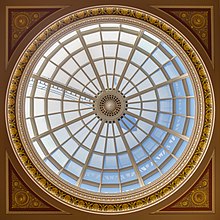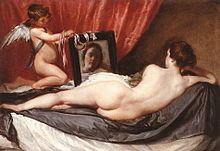National Gallery (London)

The National Gallery is an art museum in London . It is located at the north end of Trafalgar Square and is considered to be one of the most comprehensive and important picture galleries in the world. The state collection of paintings exhibited here comprises around 2,300 works from the 13th to the 19th century. Admission to the permanent painting exhibition is free. With 6.5 million visitors, the house is one of the most visited museums in the world (as of 2014).
history
The National Gallery was launched in 1824 after the British government bought the collection of Russian banker John Julius Angerstein . For the first 14 years the pictures were temporarily housed in Angerstein's house. Later, further donations from Sir George Beaumont and William Holwell Carr followed , with the condition that a more suitable building be built for the collection, which also happened in 1838. Italian painting from the 15th and 16th centuries was now the centerpiece of the still young collection, and works by masters of the late Renaissance were to follow in the next 30 years .
The collection changed in the mid-19th century as the first director, Charles Eastlake, used his absolute authority to acquire works by earlier, northern, and Italian masters. The third director, Frederic Burton, preferred eighteenth-century art and made some significant acquisitions from private English collections, such as The Envoy from Hans Holbein the Younger . After the National Gallery continued to grow, many British works were transferred to the Tate Gallery in 1897 .
In 1906, Venus in Front of the Mirror by Diego Velázquez was the first really significant work to be acquired by the National Art Collections Fund , as were many others later. The canvas in this picture was broken into by Mary Richardson in 1914 to protest the mistreatment of women. In the 19th century the National Gallery did not own any work by contemporary artists, but that changed after Hugh Lane bequeathed some Impressionist paintings to the collection in 1917 . A fund for the acquisition of modern painting was introduced in 1924 by Samuel Courtauld , through which pictures such as the bathers at Asnieres were bought by Georges Seurat . When World War II broke out, the collection was moved to a safe mine near the town of Blaenau Ffestiniog , in North Wales , while the building was used as a concert hall in London.
In recent years personalities such as Lord Sainsbury , after whom the Sainsbury wing is named, Lord Rothschild and Sir Paul Getty have been important patrons of the National Gallery.
The building
The building in Trafalgar Square was constructed by William Wilkins in 1837. He had integrated the pillars of the portico of the destroyed Carlton House into the facade. While the original plan was to also accommodate the Royal Academy of Arts , the building turned out to be too small, so that the Royal Academy had to move to Burlington House in 1868 , which is still their home today. Although more space has now been created, it did not last long for the rapidly growing collection, so an east wing was added between 1872 and 1876. Built by the classic architect Edward Middleton Barry , it is arguably the grandest part of the Victorian building with its octagonal porch . Although parts were added or rebuilt piece by piece in the years that followed, Edward Barry's symmetrical plan remained intact.
The most important addition in recent years is the Sainsbury Wing , built in 1991 and designed by Robert Venturi , a leading post-modern architect. Renaissance paintings are exhibited there.
The collection
Extracts from the collection:
Vincent van Gogh: Vincent's chair with a pipe
The Arnolfini wedding by Jan van Eyck
Directors
| Directors of the National Gallery | |
|---|---|
| Charles Lock Eastlake | 1855-1865 |
| William Boxall | 1866-1874 |
| Frederick William Burton | 1874-1894 |
| Edward Poynter | 1894-1905 |
| Charles Holroyd | 1906-1916 |
| Charles Holmes | 1916-1928 |
| Augustus Daniel | 1929-1933 |
| Kenneth Clark | 1934-1945 |
| Philip Hendy | 1946-1967 |
| Martin Davies | 1968-1973 |
| Michael Levey | 1973-1986 |
| Neil MacGregor | 1987-2002 |
| Charles Saumarez Smith | 2002-2007 |
| Nicholas Penny | 2008-2015 |
| Gabriele Finaldi | appointed August 2015 |
source
literature
- Michael Levey: A room-to-room guide to the National Gallery . F. Mildner & Sons, London 1964 (2nd rev. 1966)
- Eugen Külborn (editor): Galeria Mundi. A trip through the museums . Frankfurt am Main: Hoechst AG, 1981, without ISBN (p. 178–195 National Gallery, London )
Movies
- Frederick Wiseman : National Gallery (2014, 173 min.)
Web links
- www.nationalgallery.org.uk - Official website of the National Gallery, London (Engl.)
- The National Gallery (London) in the Google Art Project
Individual evidence
- ↑ Visitor information on the National Gallery website
- ↑ Latest Visitor Figures , ALVA, 2014. Accessed March 20, 2015 (English).
- ↑ Former information 2012 cf. Also the most visited museums in the world. In: tagesspiegel.de, October 15, 2012, accessed April 7, 2013
- ^ National Gallery: Directors . Retrieved March 20, 2015.
Coordinates: 51 ° 30 ′ 32 " N , 0 ° 7 ′ 39" W.







